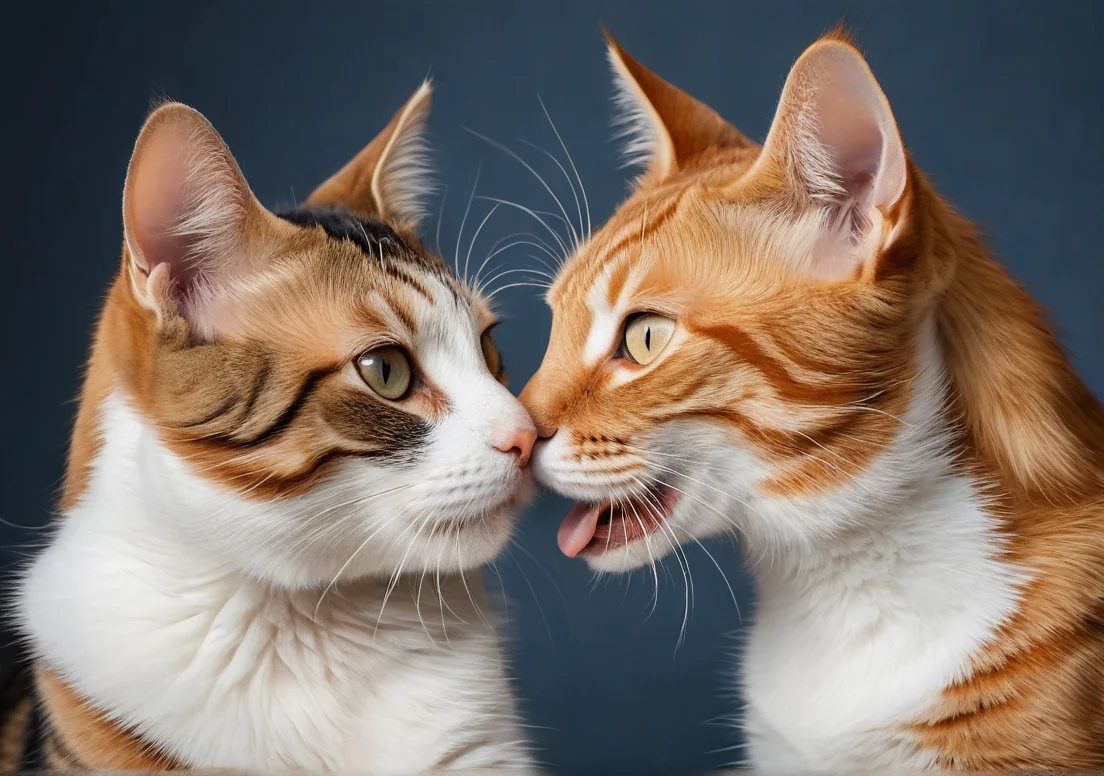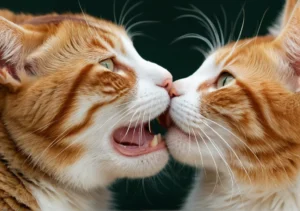Cats seem so affectionate when they groom each other, but then suddenly, chaos erupts. Ever witnessed that drastic shift from purring, licking, and friendly nudges to hissing and clawing? It leaves many cat owners baffled.
Cats lick each other as a sign of bonding and affection, but their playful nature can quickly turn competitive, leading to fights. It’s part of their instinctual behavior, managing territory and establishing social hierarchies. There’s actually a lot more beneath the surface of this behavior, and you won’t want to miss the fascinating details waiting below.

Why Do Cats Lick Each Other?
Cats grooming each other, known as allogrooming, isn’t just a casual pastime; it’s rooted in instinctual behaviors. This practice is primarily a display of affection and social bonding. By licking one another, cats exchange scents, reinforcing their social ties and forming a cohesive group. It’s a part of their natural behavior, akin to a warm hug or a friendly pat on the back among humans.
Moreover, grooming serves a practical purpose, too. It helps in removing dirt and loose fur, keeping both cats tidy. Cat owners often notice these moments of grooming as signs that their cats feel safe and comfortable in each other’s presence. Some cats may even engage in grooming to relieve stress, fostering a peaceful environment. So, when you see your felines grooming each other, they’re likely expressing their trust and affection, stitching closer their unique cat community.
What Triggers the Shift to Fighting?
The transition from a peaceful grooming session to full-blown cat brawling can happen in an instant, often driven by specific triggers. One common cause is overstimulation. Cats can become too excited or stimulated during grooming, leading to a quick shift in mood. This can happen if one cat is more playful or aggressive, and the other isn’t in the mood.
Another key factor is territorial behavior. If one cat feels that the other is encroaching on their space, the friendly licking can quickly dissolve into a spat. Play aggression also plays a role; during play, cats often use their claws and teeth, and while this can seem rough, it’s their way of practicing hunting skills.
In some cases, conflict over resources such as food, toys, or even laps can spark a fight. If one cat takes too long grooming the other, the groomed cat might become frustrated, leading to a scratch or bite to express their annoyance.
Understanding these triggers can help you manage your cats’ interactions better. Keeping an eye on their body language during those moments can give you clues. Look for signs of tension, like twitching tails or flattened ears, to intervene before the friendly grooming session takes a turn down the path of combat.
Are There Specific Behaviors to Watch For?
Cats often lick each other as a way to bond, grooming not only helps to keep their fur clean but also is a powerful social behavior. However, a sudden shift from licking to fighting can be a puzzle. To tell the difference between friendly grooming and an underlying conflict, observe these key behaviors:
Body Language: Look for signs of relaxation vs. tension. Relaxed cats typically have a low body posture and a flicking tail. In contrast, if you see stiff bodies, pinned ears, or puffed-up fur, they might be gearing up for a spat.
Vocalizations: Purring during licking indicates comfort, while hissing or growling signals displeasure. Pay attention to the volume and tone of their sounds.
Duration of Licking: If the licking is short and gentle, it’s likely friendly. Prolonged licking may lead to irritation, increasing the chances of a clash.
Context: Consider their environment. High-stress situations, such as changes in the home or the introduction of new pets, can trigger fights more easily after grooming sessions.
Understanding these behaviors can help you discern whether they’re just being affectionate or if trouble is brewing.
How Can I Reduce Fighting Between My Cats?
Conflict among cats is frustrating, but with some strategic adjustments, you can foster a calmer environment. Here are a few practical tips:
Create Separate Spaces: Ensure each cat has their own territory with essentials like food, water, scratching posts, and cozy spots. This helps minimize competition and encourages a sense of security.
Encourage Positive Interactions: Instead of forcing them together, use interactive toys to promote friendly play. Wand toys or feather chasers can shift their energy from rivalry to fun.
Use Feliway: This synthetic pheromone can help reduce tension. Spraying Feliway around your home creates a calming environment that can ease territorial disputes.
Introduce Gradually: If a new cat joins your home, introduce them slowly through a process called synergy. Allow them to sniff each other’s scent first before face-to-face meetings.
Monitor Attention: Give equal attention to each cat to prevent jealousy. Engage in one-on-one time to reduce feelings of competition.
By implementing these strategies, you’re not just reducing fights but helping create a more harmonious home, allowing your cats to feel secure and content.
Is this Behavior Normal?
Cats are complex social animals, and their interactions can sometimes seem puzzling. Grooming, also known as allogrooming, is a common behavior among cats that signifies bonding or acting as a social lubricant. When your cats lick each other, they’re likely reinforcing their social bonds, sharing scents, and even easing anxiety.
However, aggression can emerge abruptly in what appears to be a playful tussle or a sudden fight. This shift from grooming to aggression is not unusual. Cats have a unique threshold for tolerance, and their play can quickly escalate if one feels threatened or overstimulated. Signs to watch for include flattened ears, twitching tails, or a sudden halt in grooming behavior.
Keep an eye out for these shifts. If fights happen often, it might signal underlying issues like territorial disputes or stress in the environment. Addressing their needs for space and resources, such as litter boxes and feeding areas, can help maintain harmony.
Do Different Breeds Behave Differently?
Not all cats are created equal in their social tendencies. Certain breeds have unique personality traits that influence how they interact with each other. For instance, Siamese and Oriental Shorthairs are often more vocal and social, which might lead to more frequent grooming sessions. On the flip side, breeds like Persians may be a bit more aloof, potentially resulting in less grooming and more solo time.
Interestingly, research shows that breeds with a higher sociability tend to engage in grooming more would-be less likely to escalate to fights. It could be tied to their comfort level with social interaction.
Here are a few noteworthy traits of some breeds:
– Maine Coon: Generally gentle and may groom each other frequently, showing strong family bonds.
– Bengal: More energetic; they might start with grooming but can escalate to rough play or fighting quickly due to their vigorous nature.
– Ragdoll: Known for their docile nature, they typically engage in more calm and affectionate interactions.
Understanding your cats’ breeds can provide insight into their social dynamics, helping you create an environment that’s conducive to better interactions.
How Does Cat Age Affect This Behavior?
Age plays a significant role in how cats interact, especially regarding social grooming and subsequent squabbles. Younger cats often engage in more exploratory and playful behavior. They might groom each other as a way to strengthen their social bonds, but this playful grooming can escalate into roughhousing. Kittens, in particular, have a tendency to be more energetic and impulsive, which often leads to unexpected wrestling matches after a grooming session.
As cats age, their social dynamics tend to change. Older cats might be more selective with their grooming partners, showing less tolerance for rough play. They may also prioritize comfort over playful antics, leading to less grooming. However, it’s worth noting that some older cats still engage in grooming but might do so in a way that’s more relaxed and less likely to trigger a fight. The variability in age and personality can lead to complex interactions, with a few nonaggressive chases or swats that are perfectly normal, serving to maintain territorial boundaries or just to express “this is my space.”
What Interesting Facts Are There About Cat Behavior?
Social grooming, known as allogrooming, is fascinating in the feline world. It’s not just about hygiene; it’s a way for cats to establish hierarchy and social bonds. Cats often groom each other after a meal or during rest, which can signal trust and affection. Interestingly, a study showed that cats have preferred grooming partners, typically choosing those with whom they share a strong bond. You might observe your cats grooming and then suddenly play-fighting, and this behavior might be a mix of feeling secure and energetic.
Additionally, cats communicate through body language, and it’s essential to pay attention to their cues. For instance, if you see one cat gently licking another, followed by an ear flick or a twitch of the tail, it may express a change in mood or irritation, leading to a playful altercation.
Also, here’s a fun fact: research indicates that neuter status can influence aggression levels in cats. Neutered males tend to be less territorial and aggressive than unneutered males, which could affect their overall social interactions. Keeping your kitties spayed or neutered can lead to a more harmonious home.
How Do My Actions Affect Their Behavior?
Cats communicate in complex ways, and your involvement in their environment can significantly influence their behavior. When cats groom each other, it’s often a sign of affection, a way to strengthen their bond. However, the transition from grooming to fighting can be startling. It’s important to recognize that environmental factors and your actions play a key role in this dynamic.
If your cats feel stressed due to changes in their environment—a new pet, moving to a new place, or even rearranging furniture—they may exhibit more aggressive tendencies. Creating a calm and stable environment can alleviate some of this stress. Make sure they have their own safe spaces, like cozy beds or high perches, where they can retreat if needed.
Your interactions with them also matter. If you’re overly affectionate towards one and neglectful of the other, it may create feelings of jealousy and competition. To foster a harmonious relationship, ensure you’re giving both cats equal attention. You might also want to engage in play sessions that involve both, using interactive toys like feather wands or laser pointers to help build a positive connection between the two.
Another way your actions can impact their behavior is through consistency and routine. Cats thrive on predictability; keep their feeding schedules and playtimes regular. This stability can reduce anxiety and, in turn, decrease aggressive behavior. Finally, be mindful of how you react to their squabbles. Your responses can either escalate or diffuse a situation. If you intervene too harshly, it can cause even more stress and tension. Instead, try to redirect their energy with a toy or call them out to engage in a friendly game.
By being aware of how your involvement shapes your cats’ social dynamics, you can help promote a more peaceful coexistence.
Alex, a passionate animal lover, has experience in training and understanding animal behavior. As a proud pet parent to two dogs and three cats, he founded AnimalReport.net to share insights from animal experts and expand his knowledge of the animal kingdom.




